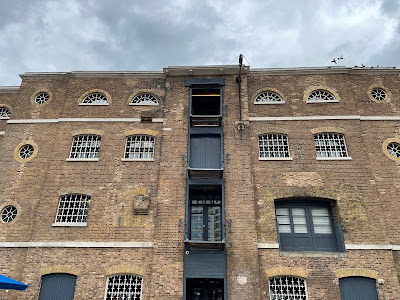.jpg) |
| The Children's area at street level |
 |
| Book sales make me happy! |
 |
| The Museum of Docklands is in an old warehouse |
"Why, Sir, you find no man, at all intellectual, who is willing to leave London. No, Sir, when a man is tired of London, he is tired of life; for there is in London all that life can afford."Best known for having compiled the first Dictionary of the English Language, Samuel Johnson spent part of his life in a townhouse that is now a museum off Fleet Street. On Friday, I decided to stop by and erroneously concluded it was shut because of all the workmen blocking the way in. As consolation, I made another trip to the nearby Shoe Lane Library where I bought five more paperbacks for £1. I told the librarian about visiting Green Knowe as I was returning my copy and she said she should read the book, looking at it dubiously. “Is it horror?” she asked. Seriously? A Stranger at Green Knowe won the Carnegie Medal – don’t librarians need to know these things?
 |
| Churchill visiting the docks during WWII |
 |
| Air Warden memorabilia |




I didn't know about the Docklands Museum. I must go there next time I'm in London. Thanks!
ReplyDelete'Really' pleased you liked the Docklands Museum, Constance. You recommend places and you can never quite be sure it'll suit the person you're recommending them to. Very pleased it all worked out.
ReplyDeleteI have been so much enjoying your posts about this trip, especially the Green Knowe visit, but everything, I remember visits to England and also special libraries like the one at the Art Institute in Chicago. I hope you continue to enjoy and to stay healthy.
ReplyDeleteI can understand being disappointed by missing out on Edinburgh, I believe it is my favorite city in the world. However, when traveling often one must concentrate on enjoying what one CAN do rather than worrying about what one can't.
You've been on the Elizabeth Line before I have! I'm glad the Museum of the Docklands is doing so well, I must get back there soon, too.
ReplyDeleteThat is good advice - to concentrate on enjoying what is happening now. My group has got too cliquey and I am finding I just go off on my own more. Of course, then I get to do what I want instead of wasting a lot of time deciding.
ReplyDeleteThere were a lot of appealing-looking eating options at Canary Wharf near the Docklands Museum so it is a good place to spend time. Cath, I emailed the Docklands to ask if they were going to do their Frost Fair talk again but have not heard back. I probably won't make it back, however.
The Elizabeth Line is so new and shiny, Liz, that it would have been my choice for a taking shelter during a Blitz. However, the tour guide said because of the fuel used during the war the tube stations would have been extremely dirty/sooty.